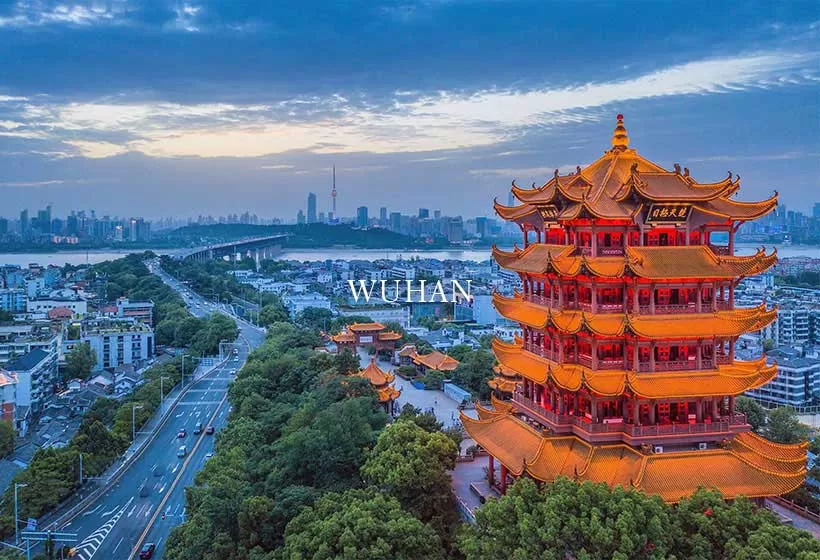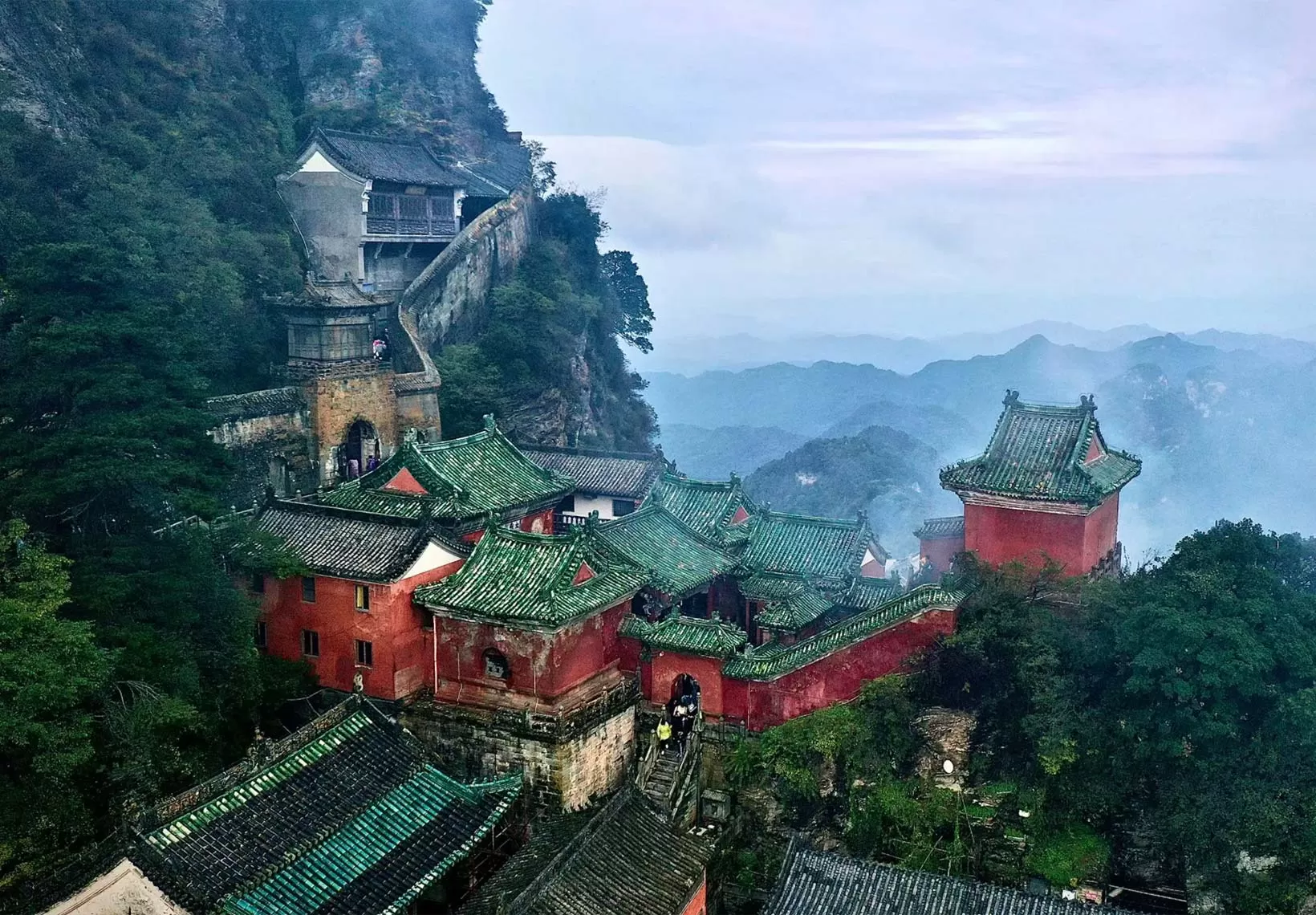Top 10 Famous Tourist Hubei Attractions and Sightseeing
Hubei Province, also known as Jingchu, is the birthplace of Chu culture and a land blessed with both natural beauty and cultural richness. The land of Jingchu boasts a long history and a splendid culture, making it a dazzling jewel in central China. Here, the Taoist aura of Wudang Mountain, the poetic charm of Yellow Crane Tower, the mystique of Shennongjia, and the grandeur of the Three Gorges Dam all intertwine. Here are the Hubei top 10 attractions.
Top 1: Yellow Crane Tower
Yellow Crane Tower, perched atop Snake Hill and overlooking the vast Yangtze River, is a landmark building of Wuhan. Originally built in the year 223 AD, it has undergone numerous reconstructions over successive dynasties. It gained widespread fame thanks to the poem Yellow Crane Tower by the poet Cui Hao. The original structure was destroyed by a fire in the late Qing Dynasty, and the present building was reconstructed in 1985.
Renowned since ancient times as "the superb sights under heaven", it is considered one of the Three Great Scenic Spots of Wuhan, along with Qingchuan Pavilion and Lute Platform. It also ranks among the Three Famous Towers of Jiangnan (south of the Yangtze), alongside Yueyang Tower in Hunan and Tengwang Pavilion in Jiangxi, and is lauded as "The First Tower Under Heaven".
The main structure of the Yellow Crane Tower is a reinforced concrete frame designed to imitate traditional wooden architecture. It stands 51.4 meters tall, with five tiers of upward-curving eaves and a pointed roof covered in golden glazed tiles. The tower is supported by 72 round columns. Surrounding the tower are bronze sculptures of two crane and a tortoise, a Sacred Stupa, memorial archways, corridors, and pavilions. On each of its four sides hang plaques, with the front displaying a golden inscription of "Yellow Crane Tower" written by the calligrapher Shu Tong.
Originally built as a military watchtower, it was constructed by Sun Quan to defend the area and monitor enemy movements during the Three Kingdoms period. As three kingdoms unified, its military function gradually transformed into that of a scenic site for banquets and leisure. Throughout the ages, countless poets and scholars have visited, leaving behind celebrated verses. Ascending the tower, one commands an unobstructed panorama of the Yangtze River stretching to the horizon and the urban landscape of Wuhan's Three Towns.
- Address: west slope of Snake Mountain, Wuchang District, Wuhan City, Hubei
- Open Hours: 08:30 AM – 05:00 PM
- Tour Length: 2-4 hours
Top 2: Enshi Grand Canyon
The Enshi Grand Canyon is located at the junction of Hunan, Chongqing, and Hubei, and rivals the majesty of Colorado Grand Canyon in US.
Perfectly situated along the mysterious 30th parallel north, the Enshi Grand Canyon is one of the longest and most beautiful canyons in the world. Stretching 108 kilometers in length and covering more than 300 square kilometers, it boasts a forest coverage rate of over 90%, offering a pristine ecological environment. Its natural scenery is poetic and picturesque, featuring 10,000-meter-long cliff galleries, thousand-feet-tall sheer waterfalls, hundreds of towering solitary peaks, and dozen miles deep gorges stretching. With a dazzling variety of strange mountains, mystical waters, peculiar caves, and rare birds, it encompasses nearly all the wonders of the natural world, which is the only place on Earth that simultaneously features a crevice, sinkhole, and stone pillar cluster, making it a natural "karst geological museum".
The Yunlong Crevice, known as "the most beautiful scar on Earth", is like U-shaped, with perfectly vertical walls. It spans 3,600 meters in length and has an average depth of 75 meters., Layers of mountain ridges rise surrounded by towering cliffs and deep ravines, while streams murmur and waterfalls cascade down inside the crevice. A Single Incense Stick, the canyon's most iconic natural wonder, is a pillar standing 150 meters tall. Its base diameter is 6 meters, narrowing to just 4 meters at its thinnest point. Immovable in wind and unshaken by rain, it has stood proudly among the peaks for millennia, silently guarding this land of mystery.
- Address: Tunpu Township, Enshi City, Enshi Autonomous Prefecture, Hubei
- Open Hours: 08:00 AM – 03:30 PM
- Tour Length: 4-8 hours
Top 3: Wudang Mountains
Wudang Mountain, originally named Xianshi and also called Taihe, lies on the southern bank of the Han River, stretching northwest to southeast for over 260 kilometers as a branch of the eastern section of the Daba Mountains. Covering a total area of 312 square kilometers, the Wudang Mountain Scenic Area is a UNESCO World Cultural Heritage site and ranks first among the Four Great Taoist Mountains in China.
Wudang Mountain boasts charming scenery and beautiful mountains and rivers, whose peaks are rugged, steep, and secluded, exuding majestic grandeur. The main peak, Tianzhu Peak, rises to 1,612 meters above sea level, standing tall like a pillar propping up the sky. The mountain is dotted with steep cliffs, deep ravines, secluded caves, and clear springs, with 3 pools, 9 springs, 11 caves, 24 gullies, 36 cliffs, and 72 peaks. Shrouded year-round in purple mist and ever-changing clouds, with shifting hues and light throughout the seasons, Wudang radiates an aura of mystery and transcendence.
Wudang Mountain is a sacred Taoist site, with many ancient Taoist buildings, once home to over 20,000 Taoist temples scattered across the mountain. The entire architectural complex is laid out according to the Taoist legend of Xuanwu, fully embodying the Taoist philosophy of harmony between heaven and humanity. It is also the birthplace of Wudang martial arts. In the late Yuan and early Ming dynasties, the Taoist priest Zhang Sanfeng integrated various martial arts teachings and founded the Wudang School, which became one of the most prominent martial arts traditions in China. Hence the saying: "Shaolin in the north, Wudang in the south."
- Address: Wudang Avenue, Danjiangkou City, Shiyan City, Hubei
- Open Hours: 08:00 AM – 05:00 PM
- Tour Length: 3-12 hours
Top 4: Shennongjia
Shennongjia National Park is located in the northwest of Hubei. It is named after Emperor Shennong, the legendary ancestor of the Chinese nation, who is said to have tasted hundreds of herbs, healed the sick, and taught people agriculture. The park borders Xiangyang to the east, is adjacent to the Wushan Mountains to the west, and offers distant views of the Wudang Mountain Scenic Area. Covering a total area of 3,253 square kilometers, with 4.293 million mu of forest, its highest peak, Shennongding (Shennong Top), reaches 3,106.2 meters above sea level, making it the tallest peak in Central China. For this reason, Shennongjia is known as "the Roof of Central China".
Shennongjia is home to a well-preserved ecosystem of primeval forests, with towering ancient trees everywhere. About 42% of the area remains an uninhabited wilderness, a natural oxygen bar. It features magnificent karst stone forests and grand waterfalls, as well as dozens of rare Precambrian plant and animal fossils, making it a natural geological museum. The sea of clouds within the area constantly forms and disperses, ever-changing in appearance, that the interplay between mist, verdant peaks, and dense forests resembles exquisite traditional Chinese Danqing paintings. Golden monkeys roam the forest in groups, pandas play leisurely, and flora and fauna coexist in harmony, making everything serene and natural.
- Address: G209, Shennongjia Forestry District, Hubei
- Open Hours: 07:30 AM – 05:30 PM
- Tour Length: 3-12 hours
Top 5: Three Gorges Dam
The Three Gorges Dam is located in the Xiling Gorge section of the Yangtze River's main stream, at the eastern end of the Three Gorges Reservoir. It stretches approximately 2,308 meters in length and stands 185 meters high, controlling a drainage area of about 1 million square kilometers. The construction began in 1994 and finished in 2009. Integrating functions such as flood control, power generation, navigation, and water resource utilization, it is the main project of the Three Gorges Hydropower Station, the core attraction of the Three Gorges Dam Tourist Area, and one of the largest hydraulic engineering projects in the world.
Climbing to the highest point, Tanziling, visitors can enjoy a panoramic view of the Three Gorges Dam. The dam resembles a giant dragon soaring into the river, holding the thundering torrents beneath it, with surging white waves at its feet and calm river waters stretching into the distance, that dynamic power and serene beauty contrasts exquisitely.
At Tanziling, visitors can hear legends of Yu the Great's flood control; at the 185 Viewing Platform, they can learn about the mechanics of the ship lift; and at the Interception Memorial Garden, they can revisit the grand scenes of the dam's construction. For even more immersive views, tourists can take the sightseeing cruise to admire the surrounding beauty. The journey is more than just a tour, that it feels like traveling through the long history of the Chinese nation's efforts to tame the waters.
- Address: Jiangxia Avenue, Sandouping Town, Yiling District, Yichang City, Hubei
- Open Hours: 08:00 AM – 05:00 PM
- Tour Length: 3-4 hours
Top 6: East Lake
East Lake, or Dong Lake, located on the right bank of the Yangtze River in the eastern part of Wuhan City, Hubei Province, is named "East Lake" due to its location. Covering a water area of 33 square kilometers, it is six times the size of West Lake in Hangzhou. Mao Zedong was especially fond of this lake and referred to it as "the place of white clouds and yellow cranes".
East Lake features beautiful lakes and mountains with winding shorelines and scattered islets, surrounded by 34 lush green peaks. Each season offers its own charm, with spring orchids, summer lotuses, autumn osmanthus, and winter plums being especially renowned. In spring, the mountains are verdant and flowers bloom with birdsong; in summer, boating on the lake is cool and pleasant; in autumn, red leaves blanket the hills and the air is filled with the fragrance of osmanthus; in winter, walk in the snow and admire the plum blossoms while migratory birds soar through the sky.
East Lake has long been a famous scenic destination. Historical figures such as Qu Yuan and Li Bai once left their footprints here. It is also the largest cultural tourism center dedicated to the Chu civilization. With rich Chu cultural heritage and elegant Chu charm, notable sites include the widely known Xingyin Pavilion, the "Three Marvels" of the Lisao Stele, the statue of Qu Yuan, as well as the Qu Yuan Memorial Hall, all brimming with cultural significance.
- Address: No. 16, Yanhu Avenue, Wuchang District, Wuhan City, Hubei
- Open Hours: 00:00 AM – 12:00 PM
- Tour Length: 2-4 hours
Top 7: Qingchuan Pavilion
Qingchuan Pavilion is located on Yugongji at the eastern foot of Guishan Mountain on the north bank of the Yangtze River. To the north, it faces the Han River, while to the east, it overlooks the Yangtze; and across the river, it stands opposite the Yellow Crane Tower, complementing each other. Originally built during the Jiajing period of the Ming Dynasty, it was rebuilt in 1984, and its name is derived from a verse by the Tang dynasty poet Cui Hao. Known as one of the "Three Great Scenic Spots of Wuhan", it enjoys the reputation of being "the first tower under the Chu". Together with the reconstructed Iron Gate Pass and the former royal palace of Yu Ji, Qingchuan Pavilion forms a complex of ancient buildings.
The pavilion consists of two stories and stands 17.5 meters high, fully embodying the architectural style of the Chu people—"building platforms against the mountain and towers upon the platforms". The two-tiered eaves have copper bells hanging from each corner, which chime in the wind. Dragon-shaped ornaments curl dynamically at both ends of the main ridge, brimming with vitality. The pavilion features whitewashed walls, gray cylindrical tiles, red-lacquered round pillars on two levels of corridors, and bracket sets and beams painted with colorful motifs, all rich in Chu cultural flavor. The ridgeline is decorated with "Chiwen (a dragon that combines the characteristics of fish)" ornaments, reflecting the folk customs of the watery regions of southern China.
- Address: No. 86, Xima Long Street, Hanyang District, Wuhan City, Hubei
- Open Hours: 09:00 AM – 05:00 PM
- Tour Length: 1-2 hours
Top 8: Three Gorges Tribe
The Tribe of Three Gorges, or Three Gorges Tribe, is located within the most magnificent section of the Xiling Gorge in the Yangtze Three Gorges, between the Three Gorges Dam and Gezhou Dam. Spanning both sides of Dengying Gorge and covering an area of 276 square kilometers, it resembles an isolated paradise hidden from the world. With its swift riverbends, peculiar rocks, secluded valleys, mysterious caves, and sweet springs, the area embodies the essence of Three Gorges culture, where Ba's vigor meets Chu's elegance, offering an unfurled scroll of the river's past and present.
Three Gorges Tribe nestles among mountains and rivers, boasting picturesque scenery. Traditional stilted houses are scattered throughout the landscape, while old sailboats and black-awning boats rest quietly in front of the villagers' homes. By the stream, young women wash clothes with wooden paddles, and on the river, fishermen cast their nets in leisurely rhythm. These enduring customs reflect the simplicity and hospitality of the people along the gorges.
Throughout history, countless poets and scholars have composed beautiful verses here. Their inspired writings speak of the tribes of Three Gorges, the sounds and figure of oars and sails, the green mountains and cascading waterfalls, the graceful peaks and fantastical rocks. Reading these poems is like stepping into the scene, fully immersed in the breathtaking landscapes and rich cultural charm of the Shipai area within the Three Gorges Tribe.
- Address: Shipai Village, Sandouping Town, Yiling District, Yichang City, Hubei
- Open Hours: 08:00 AM – 03:30 PM
- Tour Length: 3-8 hours
Top 9: Chibi Ancient Battlefield
Chibi Ancient Battlefield of the Three Kingdoms in Xianning is located on the southern bank of the middle reaches of the Yangtze River. It lies north of Wuhan and south of Yueyang, with the Yangtze River's golden waterway flowing through it. Covering an area of 3.5 square kilometers, the site carries profound historical and cultural significance, attracting countless visitors eager to explore its legacy. Strolling through the ancient battlefield, one can almost hear the beating war drums and feel the fervor of that passionate, war-torn era.
The Chibi Ancient Battlefield is the only remaining original site among the seven great battles in ancient China where the few triumphed over the many, and the weak defeated the strong. The scenic area is divided into two zones: the cultural zone and the experiential zone. The cultural zone includes historical sites such as Jinluan Mountain, where Pang Tong once studied military texts; Nanping Mountain, where Zhuge Liang borrowed the east wind; and Chibi Mountain, the front-line command post of the Sun-Liu allied forces. Visitors can follow in the footsteps of these historical figures and uncover the strategies behind their nitwit outwit. The experiential zone features architecture designed entirely based on Han Dynasty elements. Immersed in this environment, visitors often feel as if they've traveled back in time to the Three Kingdoms era.
- Address: No. 6, Wuhou Lane, Chibi Town, Chibi City, Xianning City, Hubei
- Open Hours: 08:30 AM – 05:30 PM
- Tour Length: 3-12 hours
Top 10: Tenglong Cave
Tenglong Cave Scenic Area is located just 4 kilometers from the city center. The entrance to the dry cave is an awe-inspiring 72 meters high and 64 meters wide. The total explored length of the cave reaches 59.8 kilometers, with a total area of over 2 million square meters, ranking first in the world in terms of volume.
Tenglong Cave is noted for its cave system characterized by grandeur, steepness, mystery, depth, and beauty, as well as its impressive and innovative ethnic cultural performances. The cave complex consists of five vertical levels, with five peaks inside the cave, ten large chambers, more than ten underground waterfalls, and numerous side caves, full of mystery and wonder. The cave features well-developed stalactites, ranging from breathtakingly massive formations to delicate and charming natural sculptures. Stalagmites, stone pillars, cave flowers, and stone curtains are all present, rich and vibrant. The scenic area makes full use of the vast scale of its cave chambers and has built the largest natural cave theater in China. Every day, it hosts grand immersive operas and integrated laser shows, presenting visitors with stunning, unforgettable visual spectacles.
- Address: No. 9, Tenglong Avenue, Lichuan City, Enshi Autonomous Prefecture, Hubei
- Open Hours: 08:30 AM –05:30 PM
- Tour Length: 3-8 hours
GREAT FAMILY CHINA TOUR
JULY 2024 We wanted to thank Grace at China Culture tour for organizing a great tour of China. We enjoyed our Beijing - Xian-Chengdu -Guilin -Yangshuo - Shanghai trip. Our local guides Bruce in Beijing, Susan in Xian, Jane in Chengdu, Mike in Guilin and Mary in Shanghai took care of us…read more details »
Teng Han L from SINGAPORE
Ready to Create a Unique Dream Travel?


